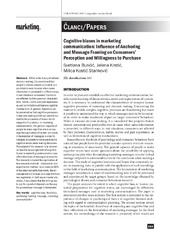Please use this identifier to cite or link to this item:
https://rfos.fon.bg.ac.rs/handle/123456789/2182Full metadata record
| DC Field | Value | Language |
|---|---|---|
| dc.creator | Bunčić, Svetlana | |
| dc.creator | Krstić, Jelena | |
| dc.creator | Kostić-Stanković, Milica | |
| dc.date.accessioned | 2023-05-12T11:34:40Z | - |
| dc.date.available | 2023-05-12T11:34:40Z | - |
| dc.date.issued | 2021 | |
| dc.identifier.issn | 0354-3471 | |
| dc.identifier.uri | https://rfos.fon.bg.ac.rs/handle/123456789/2182 | - |
| dc.description.abstract | Dok se u teoriji racionalnog donošenja odluka smatra da izbori koje vrše ljudi ostaju dosledni i predvidivi čak i u slučajevima kada se iste informacije predstavljaju na različite načine, u stvarnim situacijama odluke potrošači su pod uticajem njihovih ličnih karakteristika, navika, normi i ranijeg iskustva, kao i ograničenja ljudskih kognitivnih mehanizama. Generalno, pod heuristikama se podrazumevaju brzi kognitivni procesi u donošenju odluka koji ponekad mogu dovesti do pojave određenih pristrasnosti koje oblikuju konačne odluke. U marketinškoj komunikaciji, opšti kapacitet ljudi da prave kognitivne greške podstakao je primenu određenih principa prilikom formulisanja poruka kako bi se na taj način podstakli primaoci poruka da naprave predvidive kognitivne greške prilikom donošenja odluka. Predmet istraživanja u ovom radu je utvrđivanje kako podsticanje određenih kognitivnih pristrasnosti u marketinškoj komunikaciji može uticati na odluke primalaca poruka. Istraživanje je obuhvatilo primenu dve istraživačke metode - posmatranja i eksperimentalne metode. U čak 80% posmatranih oglasa registrovano je podsticanje bar jednog tipa kognitivne pristrasnosti. U obe eksperimentalne situacije pokazalo se da spremnost da se plati proizvod zavisi od načina formulisanja promotivne poruke. | sr |
| dc.description.abstract | While in the theory of rational decision making, it is considered that people's choices remain consistent and predictable even in cases when same information is presented in different ways, in real situations consumers' decisions are affected by their personal characteristics, habits, norms and past experience, as well as limitations of human cognitive mechanisms. In general, heuristics can be perceived as fast cognitive processes in decision making which can sometimes lead to the occurrence of biases which shape the final decision. In marketing communication, the general capacity of people to make cognitive errors encourage the application of certain principles in formulation of messages in order to instigate recipients to make predictable cognitive errors when making decisions. The subject of the research is to determine how the encouragement of cognitive biase sin marketing communication can affect decisions of messages recipients. The research included the application of two research methods observation and experimental method. In as many as 80% of the observed advertisements, the encouragement of at least one cognitive bias was registered. In both experimental situations, it was shown that the willingness to pay for a product depends on the way the promotional message is formulated. | en |
| dc.publisher | Srpsko udruženje za marketing, Beograd | |
| dc.rights | openAccess | |
| dc.rights.uri | https://creativecommons.org/licenses/by-sa/4.0/ | |
| dc.source | Marketing | |
| dc.subject | usidrenje | sr |
| dc.subject | uokviravanje | sr |
| dc.subject | poruka | sr |
| dc.subject | marketinška komunikacija | sr |
| dc.subject | kognitivna pristrasnost | sr |
| dc.subject | heuristike | sr |
| dc.subject | message | en |
| dc.subject | marketing communication | en |
| dc.subject | heuristics | en |
| dc.subject | framing | en |
| dc.subject | cognitive bias | en |
| dc.subject | anchoring | en |
| dc.title | Kognitivne pristrasnosti u marketinškoj komunikaciji - uticaj usidrenja i uokvirivanja poruka na percepciju i spremnost potrošača na kupovinu | sr |
| dc.title | Cognitive biases in marketing communication: Influence of anchoring and message framing on consumers' perception and willingness to purchase | en |
| dc.type | article | |
| dc.rights.license | BY-SA | |
| dc.citation.epage | 117 | |
| dc.citation.issue | 2 | |
| dc.citation.other | 52(2): 103-117 | |
| dc.citation.rank | M51 | |
| dc.citation.spage | 103 | |
| dc.citation.volume | 52 | |
| dc.identifier.doi | 10.5937/mkng2102103B | |
| dc.identifier.fulltext | http://prototype2.rcub.bg.ac.rs/bitstream/id/743/2178.pdf | |
| dc.identifier.rcub | conv_270 | |
| dc.type.version | publishedVersion | |
| item.cerifentitytype | Publications | - |
| item.fulltext | With Fulltext | - |
| item.grantfulltext | open | - |
| item.openairetype | article | - |
| item.openairecristype | http://purl.org/coar/resource_type/c_18cf | - |
| Appears in Collections: | Radovi istraživača / Researchers’ publications | |
This item is licensed under a Creative Commons License


